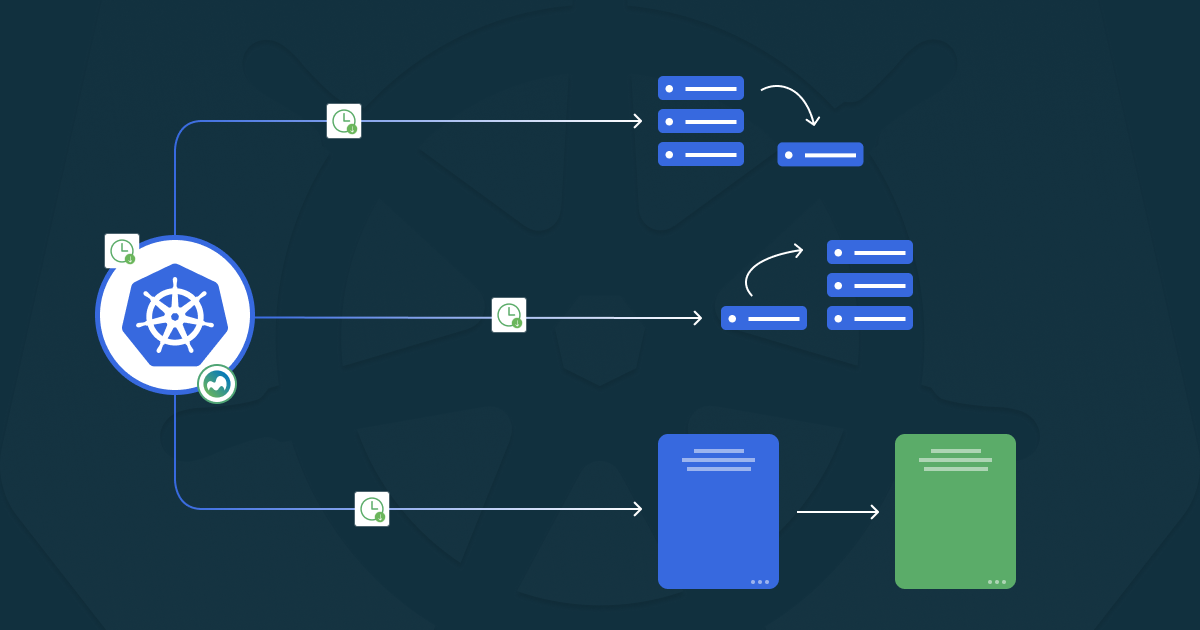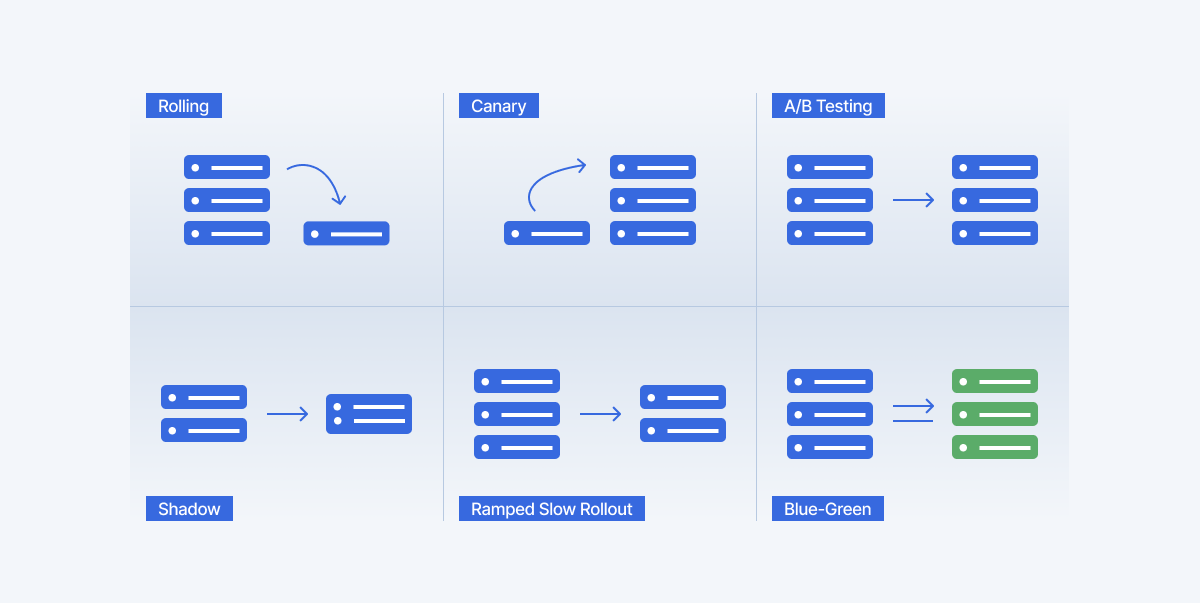Top 7 Kubernetes Deployment Strategies to Minimize Downtime

Kubernetes deployment strategies are known to ensure smooth, reliable, and efficient updates with minimal downtime when managing containerized applications. Administrators can approach application deployments through multiple deployment methods depending on the needs. The ideal strategy depends on the uptime requirements and how cautiously you want to introduce new updates into production.
It's understandable then that the right deployment strategy can dramatically improve your application's availability and risk management during updates. Join us as we explore their uses and how you can use modern tools like Mocrotica's Kubernetes deployment service to streamline the process.
What is a Kubernetes Deployment Strategy?
This strategy defines how new versions of your application are released and managed inside a Kubernetes environment. It is known to provide a structured approach to updating, scaling, and monitoring your application, ensuring changes are introduced in a controlled and predictable manner. The strategy you choose will have an impact on the following:
- How your cluster handles updates
- The amount of downtime users experience
- The risk associated with introducing new features
Deployment strategies are typically set within the Kubernetes deployment object and can be customized based on your application's requirements. This includes achieving zero downtime or validating new releases before exposing them to all users.
Different Types of Kubernetes Deployment Strategies
There are several Kubernetes deployment strategy types, each designed for different scenarios and risk profiles. Let's have a closer look at the top-rated Kubernetes deployment strategies.
Rolling Deployment
This is the default that gradually replaces old versions of an application with new ones. This means that the updates can happen smoothly without disruption. Kubernetes creates new pods, shifts traffic as they become ready, and then scales down old pods. It's a strategy that supports high availability and continuous operations because there is zero downtime, making it ideal for most production workloads.
Recreate Deployment
In contrast, the recreate strategy can stop all existing Pods before deploying new ones. It's a clean-slate approach that guarantees that no old version pods coexist with the new version but introduces downtime during the switch. It is a method that might suit non-critical applications or use cases where taking the application offline briefly isn't a concern.
The recreate deployment strategy is best for major breaking changes that require a fresh start. It's also great for applications that can tolerate scheduled downtime. While simple to implement, you must plan downtime carefully to avoid user disruption.
Blue-Green Deployment
This approach brings together two environments side-by-side: blue (current production) and green (new version). The green environment is fully prepared and tested before any live traffic reaches it, so switching over can happen instantly. If problems should occur, traffic can be quickly routed back to the blue environment in order to minimize the risk.
This blue-green deployment strategy requires double infrastructure temporarily, so it's resource-intensive but reliable for critical applications. It's a preferred strategy for its instant rollback and near-zero downtime and risk mitigation.
Canary Deployment
This is a strategy that allows only a small portion of users to access the new version initially. As you monitor its stability, more users are gradually directed to the latest version. It is a staged approach that helps catch unexpected issues early in order to reduce the impact of any potential bugs.
The canary deployment is ideal for large scale and complex apps to fine-tune new releases with minimal user impact. It's greatly beneficial for data-driven decision making during rollout.
A/B Testing
A/B testing distributes different segments of your users to different versions of your application. Analyze your feedback and behavior to make informed decisions about which version performs better. It is greatly used for feature validation and optimizing user engagement by testing different versions simultaneously.
Shadow Deployment
Meanwhile, shadow deployment introduces a new version alongside the current one but does not send real user traffic to it. Instead, requests are mirrored to the shadow instance to observe performance and correctness without affecting users. You can use it to test changes in production load conditions safely before full deployment.
Ramped Slow Rollout
The ramped slow rollout strategy slowly increases traffic to the new version by set increments, carefully monitoring system stability at each step. It balances risk and release velocity by controlling the rollout pace lightly. It fits well with monitoring -intensive environments requiring cautious deployment. The advantages include a fine-grained control and early problem detection before widespread impact.

Simplifying Strategy Implementation
Microtica’s Kubernetes Deployment Service is designed to make application rollouts and management on Kubernetes fast, intuitive, and highly reliable. It is especially true for teams without deep Kubernetes expertise.
At its core, Microtica removes the traditional pain points of deploying containerized applications by eliminating the need for manual YAML file edits and complex configuration steps. Instead, users get an automated, user-friendly platform that dramatically streamlines the deployment pipeline, from code commit to production release.
Ease of Deployment and Consistency
Teams can deploy and scale applications quickly without spending hours on manual tasks or developing advanced Kubernetes skills. Microtica's service uses standardized deployments across multiple environments. This brings consistency and predictability to application releases. It also reduces friction and minimizes deployment errors.
Integrated CI/CD Automation
Microtica tightly integrates automated CI/CD pipelines. Every change pushed to the respiratory automatically triggers builds, updates Kubernetes manifests, and initiates deployment on the user's cluster. The CI/CD engine allows developers to ship updates quickly, spot issues early, and cut deployment time from hours to minutes.
Multi-Cloud and Stack Compatibility
Microtica works seamlessly with leading cloud providers like AWS, Azure, and GCP. It also integrates well with your existing Git workflows, making it highly versatile for organizations with multi-cloud or hybrid environments.
Visibility and Real-Time Monitoring
A centralized kubernetes dashboard provides complete visibility over the entire deployment lifecycle. Users can monitor real-time logs, events, and resource use of pods and nodes. Custom metrics and alerts make it easy to track application health and performance. The system automatically surfaces key activities like deployments, errors, and restarts, supporting rapid troubleshooting.
Comprehensive Infrastructure Monitoring
Extending beyond Kubernetes, Microtica also provides unified dashboards to monitor virtual machines, databases, cloud services, and network resources. All data remains securely in your environment to ensure privacy and compliance while offering robust, low-latency monitoring.
Reliability with Health Check and Automated Robotics
Every deployment is safeguarded by built-in health checks and cluster monitoring. If an update fails or introduces problems, Microtica can automatically roll back to a previously stable version. This is used to ensure uptime and reduce deployment risks.
Automated Scaling and GitOps Integration
Microtica observes resource usage and can scale applications dynamically through intelligent cluster autoscaling. The service supports GitOps workflows that enforces infrastructure as code and maintains version control over application and infrastructure configurations. This further reduces the chance for misalignment between code and deployments.
One-Click Cluster provisioning and Developer Self-Service
Users can provision Kubernetes clusters with just one click. Microtica manages networking, scaling, and configuration, abstracting away operational complexity. This facilitates things for developers who can deploy their services through intuitive interfaces without prior knowledge of Kubernetes commands or architecture.
Conclusion
Bottom line, choosing the right Kubernetes deployment strategy depends on your application's tolerance for downtime, risk appetite, and operational complexity. Rolling updates serve most scenarios well, while blue-green and canary deployments offer safer mechanisms for critical and large-scale applications. If you require advanced testing and validation workflows, then shadow and A/B deployments should be your choice.
Use Microtica’s Kubernetes deployment service to automate and simplify the adoption of these strategies. All you have to do is master these deployment strategies for operational excellence.
Subscribe to receive the latest blog posts to your inbox every week.
*By subscribing you agree to with our Privacy Policy.

Relevant Posts



